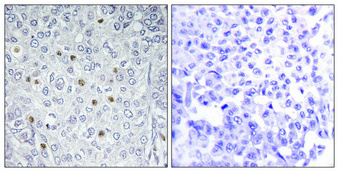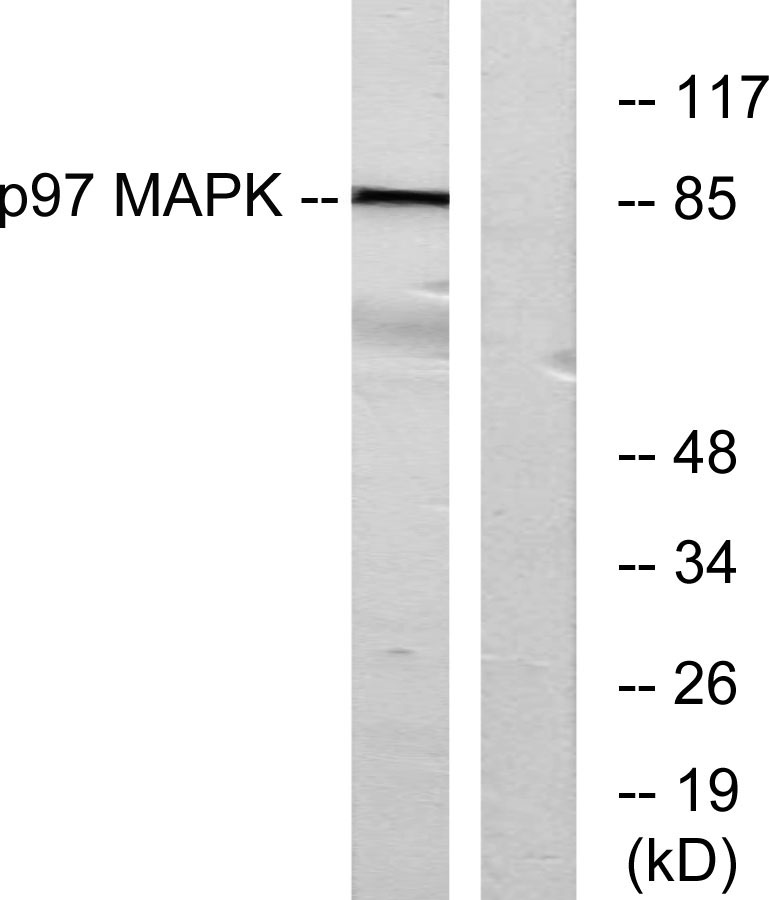ERK 3 Polyclonal Antibody
- Catalog No.:YT1628
- Applications:WB;IHC;IF;ELISA
- Reactivity:Human;Mouse;Rat
- Target:
- ERK 3
- Fields:
- >>IL-17 signaling pathway
- Gene Name:
- MAPK6
- Protein Name:
- Mitogen-activated protein kinase 6
- Human Gene Id:
- 5597
- Human Swiss Prot No:
- Q16659
- Mouse Gene Id:
- 50772
- Mouse Swiss Prot No:
- Q61532
- Rat Gene Id:
- 58840
- Rat Swiss Prot No:
- P27704
- Immunogen:
- The antiserum was produced against synthesized peptide derived from human p97 MAPK. AA range:461-510
- Specificity:
- ERK 3 Polyclonal Antibody detects endogenous levels of ERK 3 protein.
- Formulation:
- Liquid in PBS containing 50% glycerol, 0.5% BSA and 0.02% sodium azide.
- Source:
- Polyclonal, Rabbit,IgG
- Dilution:
- WB 1:500 - 1:2000. IHC 1:100 - 1:300. IF 1:200 - 1:1000. ELISA: 1:10000. Not yet tested in other applications.
- Purification:
- The antibody was affinity-purified from rabbit antiserum by affinity-chromatography using epitope-specific immunogen.
- Concentration:
- 1 mg/ml
- Storage Stability:
- -15°C to -25°C/1 year(Do not lower than -25°C)
- Other Name:
- MAPK6;ERK3;PRKM6;Mitogen-activated protein kinase 6;MAP kinase 6;MAPK 6;Extracellular signal-regulated kinase 3;ERK-3;MAP kinase isoform p97;p97-MAPK
- Observed Band(KD):
- 85kD
- Background:
- The protein encoded by this gene is a member of the Ser/Thr protein kinase family, and is most closely related to mitogen-activated protein kinases (MAP kinases). MAP kinases also known as extracellular signal-regulated kinases (ERKs), are activated through protein phosphorylation cascades and act as integration points for multiple biochemical signals. This kinase is localized in the nucleus, and has been reported to be activated in fibroblasts upon treatment with serum or phorbol esters. [provided by RefSeq, Jul 2008],
- Function:
- catalytic activity:ATP + a protein = ADP + a phosphoprotein.,cofactor:Magnesium.,domain:The TXY motif contains the threonine and tyrosine residues whose phosphorylation activates the MAP kinases.,enzyme regulation:Activated by threonine and tyrosine phosphorylation.,function:Phosphorylates microtubule-associated protein 2 (MAP2). May promote entry in the cell cycle.,PTM:Dually phosphorylated on Thr-626 and Tyr-628, which activates the enzyme.,similarity:Belongs to the protein kinase superfamily. CMGC Ser/Thr protein kinase family. MAP kinase subfamily.,similarity:Contains 1 protein kinase domain.,tissue specificity:Highest expression in the skeletal muscle, followed by the brain. Also found in heart, placenta, lung, liver, pancreas, kidney and skin fibroblasts.,
- Subcellular Location:
- Cytoplasm . Nucleus . Translocates to the cytoplasm following interaction with MAPKAPK5. .
- Expression:
- Highest expression in the skeletal muscle, followed by the brain. Also found in heart, placenta, lung, liver, pancreas, kidney and skin fibroblasts.
- June 19-2018
- WESTERN IMMUNOBLOTTING PROTOCOL
- June 19-2018
- IMMUNOHISTOCHEMISTRY-PARAFFIN PROTOCOL
- June 19-2018
- IMMUNOFLUORESCENCE PROTOCOL
- September 08-2020
- FLOW-CYTOMEYRT-PROTOCOL
- May 20-2022
- Cell-Based ELISA│解您多样本WB检测之困扰
- July 13-2018
- CELL-BASED-ELISA-PROTOCOL-FOR-ACETYL-PROTEIN
- July 13-2018
- CELL-BASED-ELISA-PROTOCOL-FOR-PHOSPHO-PROTEIN
- July 13-2018
- Antibody-FAQs
- Products Images

- Immunohistochemical analysis of paraffin-embedded Human breast cancer. Antibody was diluted at 1:100(4° overnight). High-pressure and temperature Tris-EDTA,pH8.0 was used for antigen retrieval. Negetive contrl (right) obtaned from antibody was pre-absorbed by immunogen peptide.

- Immunofluorescence analysis of MCF7 cells, using p97 MAPK Antibody. The picture on the right is blocked with the synthesized peptide.

- Western blot analysis of lysates from K562 cells, using p97 MAPK Antibody. The lane on the right is blocked with the synthesized peptide.

- Western blot analysis of the lysates from HeLa cells using p97 MAPK antibody.



